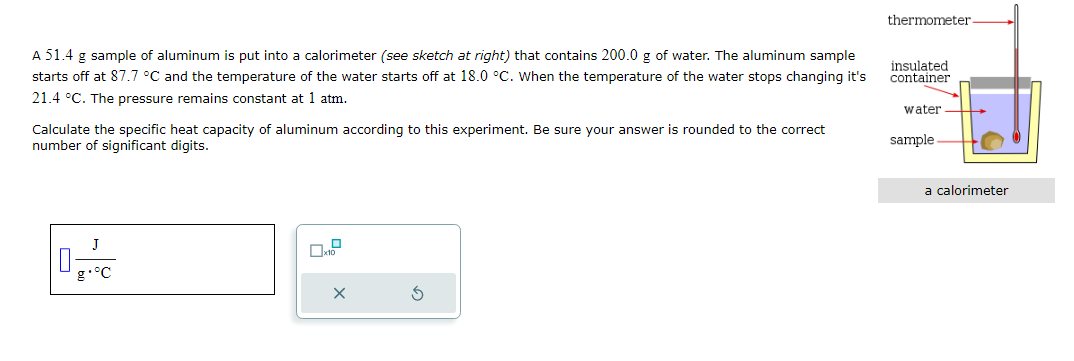A 51.4 g sample of aluminum is put into a calorimeter (see sketch at right) that contains 200.0 g of water. The aluminum sample starts off at 87.7 °C and the temperature of the water starts off at 18.0 °C. When the temperature of the water stops changing it's 21.4 °C. The pressure remains constant at 1 atm. Calculate the specific heat capacity of aluminum according to this experiment. Be sure your answer is rounded to the correct number of significant digits. J g.°C 0x X S thermometer. insulated. container water sample a calorimeter
A 51.4 g sample of aluminum is put into a calorimeter (see sketch at right) that contains 200.0 g of water. The aluminum sample starts off at 87.7 °C and the temperature of the water starts off at 18.0 °C. When the temperature of the water stops changing it's 21.4 °C. The pressure remains constant at 1 atm. Calculate the specific heat capacity of aluminum according to this experiment. Be sure your answer is rounded to the correct number of significant digits. J g.°C 0x X S thermometer. insulated. container water sample a calorimeter
Chemistry
10th Edition
ISBN:9781305957404
Author:Steven S. Zumdahl, Susan A. Zumdahl, Donald J. DeCoste
Publisher:Steven S. Zumdahl, Susan A. Zumdahl, Donald J. DeCoste
Chapter6: Thermochemistry
Section: Chapter Questions
Problem 63E: A 150.0-g sample of a metal at75.0C is added to 150.0 g H2O at 15.0C. The temperature of the water...
Related questions
Question

Transcribed Image Text:A 51.4 g sample of aluminum is put into a calorimeter (see sketch at right) that contains 200.0 g of water. The aluminum sample
starts off at 87.7 °C and the temperature of the water starts off at 18.0 °C. When the temperature of the water stops changing it's
21.4 °C. The pressure remains constant at 1 atm.
Calculate the specific heat capacity of aluminum according to this experiment. Be sure your answer is rounded to the correct
number of significant digits.
0-
X
Ś
thermometer.
insulated
container
water
sample
a calorimeter
Expert Solution
This question has been solved!
Explore an expertly crafted, step-by-step solution for a thorough understanding of key concepts.
This is a popular solution!
Trending now
This is a popular solution!
Step by step
Solved in 2 steps with 2 images

Knowledge Booster
Learn more about
Need a deep-dive on the concept behind this application? Look no further. Learn more about this topic, chemistry and related others by exploring similar questions and additional content below.Recommended textbooks for you

Chemistry
Chemistry
ISBN:
9781305957404
Author:
Steven S. Zumdahl, Susan A. Zumdahl, Donald J. DeCoste
Publisher:
Cengage Learning


Chemistry: An Atoms First Approach
Chemistry
ISBN:
9781305079243
Author:
Steven S. Zumdahl, Susan A. Zumdahl
Publisher:
Cengage Learning

Chemistry
Chemistry
ISBN:
9781305957404
Author:
Steven S. Zumdahl, Susan A. Zumdahl, Donald J. DeCoste
Publisher:
Cengage Learning


Chemistry: An Atoms First Approach
Chemistry
ISBN:
9781305079243
Author:
Steven S. Zumdahl, Susan A. Zumdahl
Publisher:
Cengage Learning

Chemistry & Chemical Reactivity
Chemistry
ISBN:
9781133949640
Author:
John C. Kotz, Paul M. Treichel, John Townsend, David Treichel
Publisher:
Cengage Learning

Chemistry & Chemical Reactivity
Chemistry
ISBN:
9781337399074
Author:
John C. Kotz, Paul M. Treichel, John Townsend, David Treichel
Publisher:
Cengage Learning

Chemistry: Matter and Change
Chemistry
ISBN:
9780078746376
Author:
Dinah Zike, Laurel Dingrando, Nicholas Hainen, Cheryl Wistrom
Publisher:
Glencoe/McGraw-Hill School Pub Co